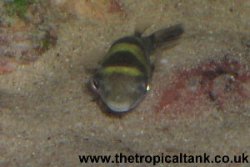|
|
Green Puffer


Photos © Sean Evans
|
| Common name: | Green Puffer, Topaz puffer, Ceylon puffer
(use of the name 'Green Spotted puffer' is best avoided to minimise confusion with D. nigriviridis) |
| Scientific name: | Dichotomyctere fluviatilis |
| Synonyms: | Tetraodon fluviatilis |
| Size: | Up to 8" (20cm), but often smaller in aquaria. |
| Origin: | Asia: Bangledesh, India, Sri Lanka. |
| Tank setup: | A brackish tank, with rocks, bogwood or robust/plastic plants for cover, and preferably a sand substrate. |
| Compatibility: | May be aggressive to their own kind or other puffers, small fish are likely to be eaten.
A group of similar-sized individuals will usually coexist realtively peacefully, but occasional biting still occurs.
Keep alone or with other larger brackish fish, such as monos and scats. |
| Temperature: | 24-28oC (75-82oF) |
| Water chemistry: | Brackish, hard and alkaline. |
| Feeding: | Live and frozen meaty foods: bloodworm, cockles and mussels, earthworms, snails. |
| Sexing: | No obvious differences. |
| Breeding: | Spawning occurs in brackish water. The eggs are laid on the substrate or a stone, and guarded
by the male. Hatching takes about a week. |
| Comments: |
One of the more commonly encountered brackish puffers, it is often confused with D. nigroviridis
(a similar brackish species, also often known as the Spotted puffer) and Tetraodon schoutedeni (Spotted Congo puffer) - a freshwater species.
There are a number of regional variants, which show variation in the pattern of their markings.
This species can be kept in freshwater when young, but should be adapted to brackish water as it grows, for its long term health.
Some fishkeepers have been able to keep this species successfully in the long term in hard and alkaline freshwater.
In the wild, they are caught over a wide range, and fish originating from freshwater areas may therefore do well in freshwater tanks, however
all individuals will thrive in brackish water whatever their origin, so this is probably the safest option for long term health.
|
Back to Puffers species list
[Home]
[Article Library]
[Fish Index]
[Tank Setups]
[Forum]
[Site Map]
|
|
|





